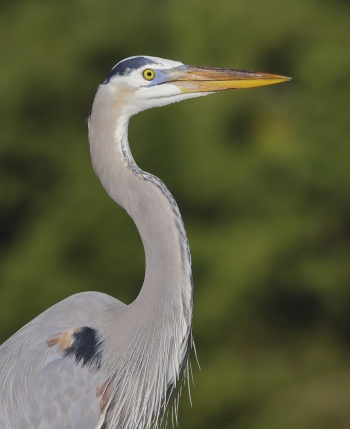Sbarnhardt (talk | contribs) (Add Clearer Species Image by katastrofa, Moved David Roach image to Behavior section from Species image) |
Sbarnhardt (talk | contribs) (Edit date in katastrofa species image) |
||
| Line 1: | Line 1: | ||
| − | [[File:Great_Blue_Heron_KAT.jpg|thumb|550px|right|Photo © by {{user|katastrofa|katastrofa}}<br />Vancouver Island, [[Canada]], | + | [[File:Great_Blue_Heron_KAT.jpg|thumb|550px|right|Photo © by {{user|katastrofa|katastrofa}}<br />Vancouver Island, [[Canada]], 5 December 2019]] |
;''[[:Category:Ardea|Ardea]] herodias'' | ;''[[:Category:Ardea|Ardea]] herodias'' | ||
==Identification== | ==Identification== | ||
Revision as of 11:22, 5 May 2021
- Ardea herodias
Identification

Photo © by David Roach
Wakodahatchee, Florida, 15 November 2018
Ht. 3-4ft 5 in (91–137 cm)
W. 6ft
- Blue-gray feathers on most of its body
- Long, pointed yellow bill
- Long legs
- Adults have white on the top of their heads and long black plumes above their eyes
Breeding plumage
- Plume of feathers on its chest and back
- Black and chestnut shoulder patch (sometimes retained all year)
- Blue lores
- Juveniles have elongated spots and stripes on their neck and upper breast area
"Great White" Heron
There is also an all white version of the Great Blue Heron, the "Great White" Heron. The great white heron was originally described as a distinct species, but is currently considered to be the white morph of Great Blue Heron. The "Great White" differs from the the Great Blue in bill morphology, head plume length, and in having a total lack of pigment in its plumage. The form is found nearly exclusively in marine waters along the coast of S. Florida. It can be seen in other regions of Florida and the Caribbean although not common. It has yellow legs, a yellow bill and white feathers.
Where the dark and white forms overlap in Florida, intermediate birds known as "Wurdemann's Herons" can be found. It is very rare and confined to extreme southern Florida and the Florida Keys. The birds white head and blue blody form resembles a Great Blue Heron (Florida race) with a white upper neck and head and it lacks the black plumes of the nominate race.
Similar species
The risk of misidentification is greatest for the "Great White Heron" type, and here are some pointers for each of a number of possible mistakes:
- Great Egret has yellow bill but black legs (yellow legs in Great White Heron)
- Snowy Egrets have a black bill and black legs, both of which are wrong for this species (do look at juveniles that are less clear-cut) and the bill is finer and more pointed
- Cattle Egret would have a much smaller bill and shorter legs
- Juvenile Little Blue Heron or white morph Reddish Egret would not have a yellow bill or yellow on the legs.
Distribution
It is found throughout most of North America, including Alaska, Quebec and Nova Scotia. The range extends south through Florida, Mexico and the Caribbean to South America.
Very rare vagrant to the Azores and United Kingdom.
Migrates in the fall, although some stay in the northern part of their range.
Taxonomy

Photo © by Zackiedawg
Delray Beach, Florida, 21 January 2012
Subspecies
Five subspecies are recognized[1]:
- A.h. fannini:
- South-eastern Alaska to coastal Washington
- A.h. herodias:
- Southern Canada to southern Baja California and Central America
- A.h. wardi:
- A.h. occidentalis:
- Southern Florida through West Indies to islands off Venezuela
- A.h. cognata:
Habitat
Margins of lakes and slow-flowing rivers, swamps and marshes, frequently on sea-coasts, in estuaries and mangroves.
Behaviour

Photo © by David Roach
Wakodahatchee, Florida, USA, 26 November 2018
Actions
Usually tucks its head into an S-shape when it is resting and flying.
Diet
Their main diet consists of fish.
Breeding
Colonial. Nest usually in a tree built primary from sticks, but when nesting on the ground can also use other materials such as Salt Grass. Clutch is usually two to three pale blue eggs.
Vocalisation
Common call is a rapid squawk given day and night when alarmed or when being aggressive.
Movements
Marked post-breeding dispersal in North America, especially in North-Center of continent.
References
- Clements, J. F., T. S. Schulenberg, M. J. Iliff, S. M. Billerman, T. A. Fredericks, B. L. Sullivan, and C. L. Wood. 2019. The eBird/Clements Checklist of Birds of the World: v2019. Downloaded from http://www.birds.cornell.edu/clementschecklist/download/
- Martínez-Vilalta, A., Motis, A. & Kirwan, G.M. (2020). Great Blue Heron (Ardea herodias). In: del Hoyo, J., Elliott, A., Sargatal, J., Christie, D.A. & de Juana, E. (eds.). Handbook of the Birds of the World Alive. Lynx Edicions, Barcelona. (retrieved from https://www.hbw.com/node/52675 on 25 February 2020).
- Thread in the id forum discussing the "Great White" form
- BirdForum Member observations
- Blake, E. R. 1977. Manual of Neotropical Birds. Volume 1. University of Chicago Press, Chicago, Illinois.
- Hancock, J. & H. Elliott (1978) The Herons of the World. Harper & Row
- Palmer, R. (1962) Handbook of North American Birds, Vol 1: Loons through Flamingos. Yale Univ. Press.
- Vennesland, R. G. and R. W. Butler (2020). Great Blue Heron (Ardea herodias), version 1.0. In Birds of the World (A. F. Poole, Editor). Cornell Lab of Ornithology, Ithaca, NY, USA. https://doi.org/10.2173/bow.grbher3.01
Recommended Citation
- BirdForum Opus contributors. (2025) Great Blue Heron. In: BirdForum, the forum for wild birds and birding. Retrieved 15 January 2025 from https://www.birdforum.net/opus/Great_Blue_Heron
External Links








